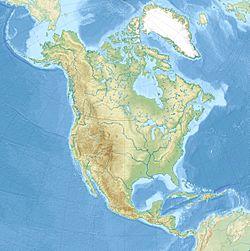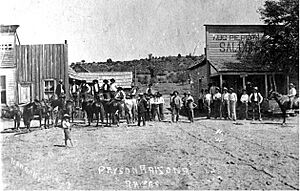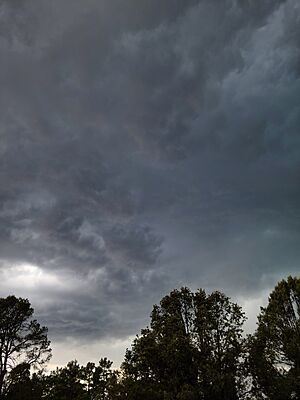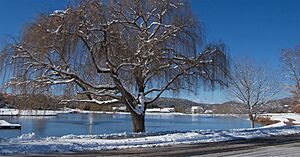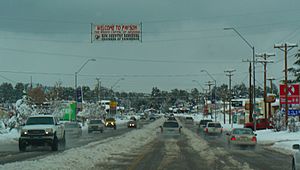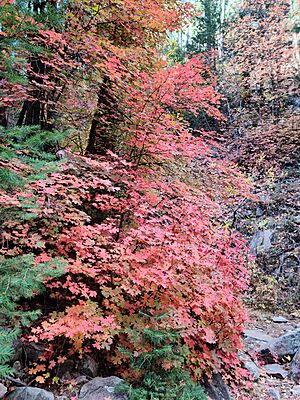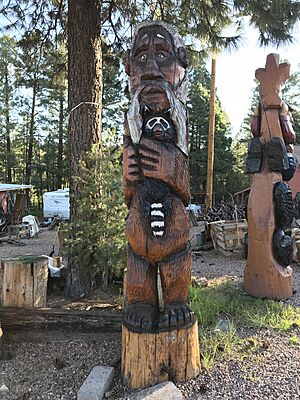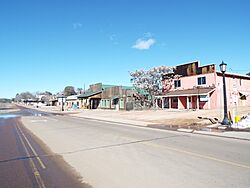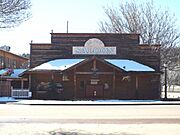Payson, Arizona facts for kids
Quick facts for kids
Payson, Arizona
|
||
|---|---|---|
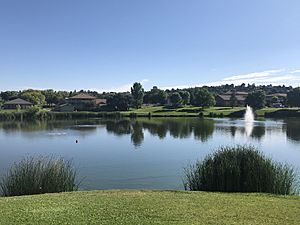
Green Valley Park
|
||
|
||
| Motto(s):
"Arizona's Cool Mountain Town"
|
||
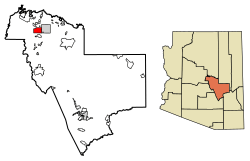
Location of Payson in Gila County, Arizona
|
||
| Country | United States | |
| State | Arizona | |
| County | Gila | |
| Incorporated | 1973 | |
| Government | ||
| • Type | Council-manager | |
| • Body | Payson Town Council | |
| Area | ||
| • Total | 19.36 sq mi (50.13 km2) | |
| • Land | 19.35 sq mi (50.11 km2) | |
| • Water | 0.01 sq mi (0.02 km2) | |
| Elevation | 5,100 ft (1,554.48 m) | |
| Population
(2020)
|
||
| • Total | 16,361 | |
| • Density | 845.10/sq mi (326.30/km2) | |
| Time zone | UTC-7 (MST (no DST)) | |
| ZIP codes |
85541, 85547
|
|
| Area code(s) | 928 | |
| FIPS code | 04-53700 | |
| GNIS ID(s) | 32746, 2413121 | |
Payson (Navajo: Ndzistsooí) is a town in northern Gila County, Arizona, United States. Due to Payson's location being very near to the geographic center of Arizona, it has been called "The Heart of Arizona". The town is surrounded by the Tonto National Forest, the largest of the six national forests in Arizona and the ninth largest national forest in the United States.
Payson boasts a lively festival calendar, including The World's Oldest Continuous Rodeo, established in 1884, as well as the Arizona State Old Time Fiddlin' Championship which celebrates the area's musical heritage.
As of the 2020 census, the population of Payson was 16,361.
Contents
History
Prior to the arrival of European-American settlers, the area was known as Te-go-suk—or Place of the Yellow Water—by the Dilzhe'e Apache. The area was also historically inhabited by the Yavapai and Puebloan peoples, including the Hohokam, Mogollon, and Sinagua cultures.
In 1882, considered to be the founding year of Payson, area settlers established a logging, mining, and ranching hamlet called “Green Valley."
That same year, the Battle of Big Dry Wash—fought between troops of the United States Army's 3rd Cavalry Regiment, 6th Cavalry Regiment, and members of the White Mountain Apache Tribe—took place just north of town on the Mogollon Rim. The battle occurred within the greater context of the Apache Wars.
On March 3, 1884, a post office was built in Green Valley with the help of Illinois Representative Levi Joseph Payson. In honor of the representative's help, the town's name was changed to "Payson".
Payson held its first rodeo in 1884. The town declares the competition to be the world's oldest and continuous rodeo as it has been held every year since.
In 1918, author Zane Grey made his first trip to the area surrounding Payson. He would visit with regularity through 1929, and he purchased two plots of land near Tonto Creek, including 120 acres (49 ha) from Sampson Elam Boles under Myrtle Point. Grey wrote numerous books about the area, and he also filmed movies in the area, such as To the Last Man. His cabin is located in Green Valley park.
During Prohibition, the manufacture, sale, and distribution of liquor was plentiful in Payson. These transactions took place on historic Bootleg Alley. “Payson Dew,” brewed across 30 to 40 stills in the Payson area, was coveted from as far away as Los Angeles. The drink helped to reinvigorate Payson’s economy.
During the 1930s, an effort was initiated to better connect Payson to the outside world through the construction of roads and highways. At that time, the town was very isolated—with a trip from Phoenix to Payson taking eight to twelve hours. Throughout the 1950s, work progressed on a paved road from Phoenix to Payson, and the road was completed in 1958. The highway, State Route 87 (also known as the "Beeline Highway"), was later expanded to four lanes.
Payson was officially incorporated in 1973.
Ellison Creek & East Verde River flooding
On July 15, 2017, heavy rains from upstream of the creek and river caused the waterways to swell, subsequently leading to downstream flooding. This flash flood crucially affected the popular Water Wheel swimming hole where 10 people were killed and 4 others were injured.
Geography
Payson is located in northern Gila County—within the hilly and mountainous terrain of the Arizona transition zone. The town sits at an elevation of 5,000 feet (1,500 m), and it has a total area of 19.5 square miles (51 km2). The Mogollon Rim, the southern boundary of the Colorado Plateau, lies to the north of Payson, with elevations exceeding 7,500 feet (2,300 m). There are several cold water lakes on top of the rim; they are stocked with fish by the Arizona Game and Fish Department.
Payson is adjacent to the Tonto Apache Reservation, and it is bordered to the east by the town of Star Valley. Other nearby communities are Pine, Strawberry, Gisela and Rye, all within Gila County. Globe, the Gila County seat, is 80 miles (130 km) to the south via State Routes 87 and 188. State Route 87, the Beeline Highway, leads 90 miles (140 km) southwest to Phoenix and 90 miles (140 km) northeast to Winslow. State Route 260 leads 90 miles (140 km) east to Show Low.
Zane Grey Country
"Zane Grey Country" is a term for the area around Payson. This term was most often used in the 1970s and 1980s, and appeared in the header of the local newspaper, the Payson Roundup. In recent times, it has fallen somewhat out of favor, as the term "Rim Country" has become more popular among locals.
Climate
Owing to its elevation of 5,000 feet (1,500 m), Payson is in a transitional area between a hot-summer Mediterranean climate (Köppen Csa) and a cold semi-arid climate (Köppen BSk). The town straddles USDA Hardiness Zone 7b and 8a, and it is surrounded by high desert pinyon-juniper woodlands; ponderosa pine; stands of Arizona cypress and live oak; and the mixed conifer forests of the Mogollon Rim escarpment.
While average summer daytime temperatures climb above 90 °F (32 °C), the town's elevation keeps it protected from the extreme heat found in Arizona's lowland deserts—though temperatures do occasionally reach 100 °F (38 °C). Early summer is characterized by hot and dry weather, with elevated wildfire risk, whereas mid-to-late summer is tempered by the North American Monsoon. The monsoon brings frequent, sometimes severe thunderstorms with heavy rain, strong winds, hail, and flash floods. On average, Payson receives 7 inches (180 mm) of monsoonal moisture—approximately 35% of its annual precipitation—across the months of July, August, and September.
Diurnal temperature variation is large throughout the year. Even in summer, the difference between daytime highs and nighttime lows exceeds 30 degrees.
Winter is often sunny with mild days and cold nights. In December and January, nighttime lows typically fall below 32 °F (0 °C)—with the coldest nights of the year falling below 20 °F (−7 °C). By mid-afternoon, however, average daytime temperatures surpass 50 °F (10 °C). While most winter precipitation falls as rain, Payson receives an average of 18.5” of snow each year, spread across six days of measurable snowfall. Snow melts quickly, and any lingering snow cover is minimal.
Desert wildflowers are common in the spring. Blooms include a fiery array of Indian paintbrush blossoms, primroses, poppies, lupines, larkspurs, daisies, and the golds and fuchsias of cactus flowers (and other brightly colored wildflowers).
| Climate data for Payson, Arizona (1991–2020 normals, extremes 1940–present) | |||||||||||||
|---|---|---|---|---|---|---|---|---|---|---|---|---|---|
| Month | Jan | Feb | Mar | Apr | May | Jun | Jul | Aug | Sep | Oct | Nov | Dec | Year |
| Record high °F (°C) | 77 (25) |
80 (27) |
89 (32) |
91 (33) |
99 (37) |
106 (41) |
107 (42) |
104 (40) |
103 (39) |
94 (34) |
83 (28) |
77 (25) |
107 (42) |
| Mean maximum °F (°C) | 66.9 (19.4) |
68.4 (20.2) |
75.6 (24.2) |
82.9 (28.3) |
90.2 (32.3) |
97.8 (36.6) |
99.8 (37.7) |
97.6 (36.4) |
92.9 (33.8) |
86.3 (30.2) |
75.3 (24.1) |
66.9 (19.4) |
101.1 (38.4) |
| Mean daily maximum °F (°C) | 56.1 (13.4) |
58.5 (14.7) |
65.1 (18.4) |
71.6 (22.0) |
80.0 (26.7) |
90.2 (32.3) |
92.5 (33.6) |
90.5 (32.5) |
85.9 (29.9) |
75.9 (24.4) |
64.3 (17.9) |
54.9 (12.7) |
73.8 (23.2) |
| Daily mean °F (°C) | 41.0 (5.0) |
43.0 (6.1) |
48.4 (9.1) |
53.8 (12.1) |
61.4 (16.3) |
70.5 (21.4) |
76.0 (24.4) |
74.8 (23.8) |
68.9 (20.5) |
58.3 (14.6) |
47.7 (8.7) |
40.2 (4.6) |
57.0 (13.9) |
| Mean daily minimum °F (°C) | 26.0 (−3.3) |
27.7 (−2.4) |
31.6 (−0.2) |
36.0 (2.2) |
42.8 (6.0) |
50.8 (10.4) |
59.5 (15.3) |
59.2 (15.1) |
51.9 (11.1) |
40.6 (4.8) |
31.0 (−0.6) |
25.6 (−3.6) |
40.2 (4.6) |
| Mean minimum °F (°C) | 14.0 (−10.0) |
17.9 (−7.8) |
21.3 (−5.9) |
26.3 (−3.2) |
33.5 (0.8) |
41.4 (5.2) |
51.0 (10.6) |
52.2 (11.2) |
41.9 (5.5) |
30.2 (−1.0) |
19.5 (−6.9) |
14.5 (−9.7) |
11.7 (−11.3) |
| Record low °F (°C) | −8 (−22) |
1 (−17) |
3 (−16) |
15 (−9) |
22 (−6) |
31 (−1) |
39 (4) |
37 (3) |
33 (1) |
16 (−9) |
6 (−14) |
−9 (−23) |
−9 (−23) |
| Average precipitation inches (mm) | 2.27 (58) |
2.33 (59) |
1.89 (48) |
0.82 (21) |
0.54 (14) |
0.21 (5.3) |
2.81 (71) |
2.60 (66) |
1.54 (39) |
1.26 (32) |
1.48 (38) |
2.09 (53) |
19.84 (504) |
| Average snowfall inches (cm) | 4.7 (12) |
4.9 (12) |
2.0 (5.1) |
2.0 (5.1) |
0.0 (0.0) |
0.0 (0.0) |
0.0 (0.0) |
0.0 (0.0) |
0.0 (0.0) |
0.0 (0.0) |
1.3 (3.3) |
3.6 (9.1) |
18.5 (47) |
| Average precipitation days (≥ 0.01 inch) | 5.3 | 5.8 | 5.0 | 3.0 | 2.6 | 1.4 | 8.8 | 11.1 | 5.0 | 4.3 | 3.9 | 5.6 | 61.8 |
| Average snowy days (≥ 0.1 inch) | 1.6 | 1.3 | 0.8 | 0.4 | 0.0 | 0.0 | 0.0 | 0.0 | 0.0 | 0.0 | 0.5 | 1.3 | 5.9 |
| Source 1: NOAA | |||||||||||||
| Source 2: National Weather Service | |||||||||||||
Demographics
| Historical population | |||
|---|---|---|---|
| Census | Pop. | %± | |
| 1970 | 1,787 | — | |
| 1980 | 5,068 | 183.6% | |
| 1990 | 8,377 | 65.3% | |
| 2000 | 13,620 | 62.6% | |
| 2010 | 15,301 | 12.3% | |
| 2020 | 16,351 | 6.9% | |
| U.S. Decennial Census | |||
As of the census of 2019, there were 15,297 people living in Payson, AZ and is the 2,788th largest city in the United States. 5,832 households, and 4,070 families residing in the town. The population density was 791 people per square mile, which is 1275% higher than the Arizona average and 773% higher than the national average. There were 7,033 housing units at an average density of 361.2 per square mile (139.5/km2). The racial makeup of the town was 92.5% White, 0.2% Black or African American, 2.6% Native American, 0.5% Asian, <0.1% Pacific Islander, 3.0% from other races, and 1.3% from two or more races. 9.3% of the population were Hispanic or Latino of any race.
There were 5,832 households, out of which 21.7% had children under the age of 18 living with them, 58.6% were married couples living together, 8.0% had a female householder with no husband present, and 30.2% were non-families. 26.0% of all households were made up of individuals, and 14.6% had someone living alone who was 65 years of age or older. The average household size was 2.30 and the average family size was 2.71.
In the town, the population was spread out, with 18.1% under the age of 18, 4.6% from 18 to 24, 15.3% from 25 to 44, 25.9% from 45 to 64, and 36.2% who were 65 years of age or older. The median age was 57.1 years. This is approximately 54% higher than the Arizona average of 37. The male/female ratio was 0.9:1. English was spoken by 93% of people and Spanish was spoken by 5% of people.
The median income for a household in the town was $33,638, and the median income for a family was $38,713. Males had a median income of $30,900 versus $23,750 for females. The per capita income for the town was $19,513. About 6.5% of families and 9.9% of the population were below the poverty line, including 15.1% of those under age 18 and 4.7% of those age 65 or over.
Recreation
The United States Forest Service has jurisdiction of 97% of the land around Payson; the town is surrounded by the Tonto National Forest and by tribal governments. Much of the land is available for recreational activities. Payson is home to several hiking trails—notably the Cypress/Boulders trail system and nearby Mogollon Rim trails (including Horton Creek trail). The Tonto Natural Bridge, the largest known natural bridge in the world, is located just northwest of Payson in Tonto Natural Bridge State Park, a unit of the Arizona State Park system. The area incorporates three golf courses, two of which belong to private country clubs. Mazatzal Casino, a tribal casino, is operated by the Tonto Apache Reservation near the south end of town.
The Payson area is a popular destination for rock hounds. In various areas surrounding the community, quartz crystals can be found, some rivaling Herkimer diamonds in quality, as well as geodes, agate and onyx. Fossils are commonly found in the Paleozoic strata that is exposed along the Mogollon Rim to the north and west of Payson along State Route 87 and State Route 260.
Payson has two parks, Green Valley Park and Rumsey Park. It also has two lakes, which are part of the Urban Fish Program. Payson hosts free outdoor concerts in the summer. Other activities include intramural sports like baseball and football. Payson also has a small skate park.
Payson hosts a Fourth of July fireworks display at Green Valley Park.
Culture
Payson is the site of the annual Arizona State Old Time Fiddlin' Championship, held in September. The fiddle contest features both local and nationally known instrumentalists, and it awards cash prizes.
Rodeos
Payson hosts two rodeos. In May, the Multi-Purpose Event Center near the Tonto Apache Reservation hosts the Gary Hardt Memorial Rodeo. In August, Payson hosts the historic August Doin's Rodeo (1884), which makes Payson the "Home of the World's Oldest Continuous Rodeo". Prescott, Arizona, 100 miles to the northwest, is known for hosting the "World's Oldest Rodeo" (1888), but it took a hiatus during World War II.
Mogollon Monster
Forestlands surrounding Payson, and throughout central, northern, and eastern Arizona, serve as the backdrop to the legend of the Mogollon Monster—described as a large, bipedal, ape-like creature with a pungent smell, similar to Bigfoot. The legend came to local prominence in 1947 when a "big, hairy beast" raided a Boy Scout camp near Tonto Creek.
Public services
Education
The town is served by the Payson Unified School District.
A branch of Gila Community College is located in Payson.
Police department
The Payson Police Department serves both the Town of Payson and Town of Star Valley. As of 2022[update], the department is authorized to staff 32 sworn officers which includes the chief, lieutenant, five sergeants, four detectives, two school resource officers, two speciality positions (GIITEM and Traffic), and patrol. In 2021, officers responded to more than 16,000 calls for service.
The police department also staffs a 24/7 dispatch center that is the primary public safety answering point (PSAP) for northern Gila County. In addition to dispatching for Payson PD, they also dispatch for the Tonto Apache Police Department, Town of Payson Fire Department, Hellsgate Fire District, Pine/Strawberry Fire District, Christopher Kohls Fire District, Waterwheel Fire District, and Gisela Valley Fire District.
Transportation
The Payson Senior Center operates the Beeline Bus, which provides local bus service to Payson, Star Valley, and Mesa del Caballo. Mountain Valley Shuttle stops in Payson on its Phoenix–Show Low route.
Historic structures
The following are images of some of the historic structures recognized by the local government.
- The Haught Cabin – Henry and Sarah Haught built their log cabin in 1904 of alternating layers of logs and chinking in Roberts Mesa. The Haught's cabin measured 10′ by 18′. It had a dirt floor and no windows. The cabin was moved to Tonto Creek and by 1930, it was abandoned. In 1999, the cabin was moved once more, this time to the Green Valley Park and reassembled on the museum's grounds which is located at 700 South Green Valley Parkway.
- The Sidles Mud House – Henry Sidles built the poured mud home in 1882. The mud house, located at 505A W. Main Street, was later purchased by August and Wilhelmina Pieper.
- The Pieper Mansion – August and Wilhelmina Pieper built a new house which became known as the "Pieper Mansion" in 1893. Located at 505 W. Main Street, the Piepers moved in and used the Sidles mud house for storage.
- The Ranger Station – This is the oldest Ranger Station still standing in the Southwest. It belonged to the Payson Ranger District of the National Tonto Forest. The station was built in 1907.
- The Ranger Family House – was built in 1933 and is the oldest Ranger Family House still standing in the Southwest.
- The Ranger Office – was built in 1932 and together with the Ranger Station and the Ranger Family House completes the ranger complex of the Payson Ranger District. The three properties are located on the grounds of what is now the Green Valley Park.
- The Ox Bow Inn and Saloon – built in 1933 and located at 607 W Main Street. The log inn was built as the Payson Hotel and the restaurant was named the Busy Bee. In 1945 the business was purchased and expanded by Jimmy Cox, who renamed the hotel the Ox Bow Inn. The property was listed in the National Register of Historic Places on October 1, 2004, ref.: #04001073.
- The Tonto Natural Bridge – The landscape formation is believed to be the largest natural travertine bridge in the world.
See also
 In Spanish: Payson (Arizona) para niños
In Spanish: Payson (Arizona) para niños





